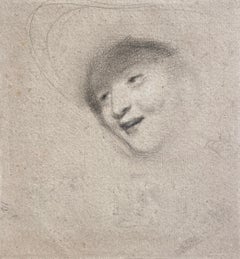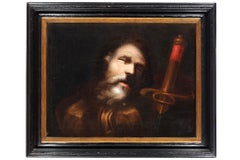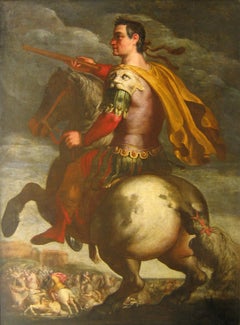Henry Perronet Briggs Art
to
1
1
2
2
1
1
Overall Height
to
Overall Width
to
1
2
2
1
1
1
1
1
1
2
2
6,857
3,171
2,516
1,217
1
1
1
1
1
Artist: Henry Perronet Briggs
Graphite Study of a Head, Monogrammed Victorian Sketch, Gilt Fame
By Henry Perronet Briggs
Located in London, GB
Graphite on paper, monogrammed lower left
Image size: 6 x 6 1/2 inches (15.25 x 16.5 cm)
Contemporary style handmade gilt frame
Henry Perronet Briggs
Henry Perronet Briggs RA wa...
Category
Early 19th Century Henry Perronet Briggs Art
Materials
Graphite, Paper
Juliet and her Nurse with the Page Peter from Shakespeare's Romeo and Juliet
By Henry Perronet Briggs
Located in Long Island City, NY
Artist: Henry Perronet Briggs, Attributed to, English (1793 - 1844)
Title: Juliet and Her Nurse with the Page Peter from Shakespeare's Romeo and Juliet
Year: circa 1820
Medium: Oil o...
Category
1820s Old Masters Henry Perronet Briggs Art
Materials
Canvas, Oil
Related Items
17th Century by Juan Alfonso Abril Head of St Paul Painting Oil on Canvas
Located in Milano, Lombardia
Juan Alfonso Abril (active in the 17th century in Valladolid)
Head of Saint Paul
Oil on canvas, cm. 48,5 x 62 - with frame cm. 63 x 76,5
Shaped wooden f...
Category
Early 17th Century Old Masters Henry Perronet Briggs Art
Materials
Canvas, Oil
H 19.1 in W 24.41 in D 1.97 in
Julius Caesar on Horseback
By Antonio Tempesta
Located in New York, NY
Provenance: Private Collection, South America
Antonio Tempesta began his career in Florence, working on the decoration of the Palazzo Vecchio under the direction of Giorgio Vasari. He was a pupil first of Santi di Tito...
Category
16th Century Old Masters Henry Perronet Briggs Art
Materials
Oil, Canvas
Study of a Sleeping Girl in a Cap
By Jean-Baptiste Greuze
Located in Middletown, NY
Graphite on greenish gray wove paper. 15 1/4 x 11 5/8 inches (390 x 295 mm). Initialed "G. B." in pencil on the lower right recto. In generally good condition with some minor scattered surface soiling. Condition is consistent with age.
____
This drawing is closely related to two known mid 18th century oils...
Category
18th Century Old Masters Henry Perronet Briggs Art
Materials
Handmade Paper, Graphite
"Veneer" Figurative Drawing, Color Pencil, Ballpoint Pen, Graphite
By Lauren Rinaldi
Located in Philadelphia, PA
"Veneer" is an original oil pastel, ballpoint pen, color pencil, and graphite on arches paper work by Lauren Rinaldi. This piece ships in the pictured archival custom frame. The pape...
Category
21st Century and Contemporary Contemporary Henry Perronet Briggs Art
Materials
Archival Paper, Oil Pastel, Ballpoint Pen, Color Pencil, Graphite
Landscape Near Felday, Surrey
By Abraham Hulk the Younger
Located in Hillsborough, NC
Dutch/English artist Abraham Hulk the Younger (1851-1922) is most known for landscapes of the British countryside. This work is one of a pair (the second work is also available by s...
Category
Late 19th Century Old Masters Henry Perronet Briggs Art
Materials
Oil, Canvas
17th Century By Mondino Mystic Marriage of St Catherine of Alexandria Oil/Canvas
Located in Milano, Lombardia
"Cassetta" frame in sculpted, carved and gilded wood.
Antonio Mondino (information from c. 1610 to c. 1626) was an Italian artist who was active from 1617 to 1633. The painting, whi...
Category
17th Century Old Masters Henry Perronet Briggs Art
Materials
Canvas, Oil
H 34.45 in W 39.38 in D 1.97 in
Shipping in Stormy Waters, Attributed to Italian Artist Francesco Guardi
By Francesco Guardi
Located in Stockholm, SE
The splendour of the tragic sea
Francesco Guardi and maritime painting in Venetian art
No Venetian painter was a stranger to the sea. After all, Venice was not only one of the most prominent ports of the Mediterranean, but indeed a city literally submerged in the ocean from time to time. Curiously however, the famous Venetian school of painting showed little interest in maritime motifs, favouring scenes from the iconic architecture of the city rather than seascapes. That is why this painting is a particularly interesting window into not only the painter Francesco Guardi himself – but to the significance of the element of water in art history, in absence as well as in the centre of attention.
Whether it be calm, sunny days with stunning views of the palaces alongside the canals of Venice or – more rarely – stormy shipwrecking tragedies at sea, water as a unifying element is integral to the works of painter Francesco Guardi (1712–1793). During his lifetime, Venetian art saw many of its greatest triumphs with names like Tiepolo or Canaletto gaining international recognition and firmly establishing Venice as one of the most vibrant artistic communities of Europe. While the city itself already in the 18th century was something of an early tourist spot where aristocrats and high society visited on their grand tour or travels, the artists too contributed to the fame and their work spread the image of Venice as the city of romance and leisure to an international audience, many of whom could never visit in person.
Still today, the iconic image of Venice with its whimsical array of palaces, churches and other historic buildings is much influenced by these artists, many of whom have stood the test of time like very well and remain some of the most beloved in all of art history. It was not primarily subtility, intellectual meanings or moral ideals that the Venetian art tried to capture; instead it was the sheer vibrancy of life and the fast-paced city with crumbling palaces and festive people that made this atmosphere so special. Of course, Venice could count painters in most genres among its residents, from portraiture to religious motifs, history painting and much else. Still, it is the Vedutas and views of the city that seems to have etched itself into our memory more than anything else, not least in the tradition of Canaletto who was perhaps the undisputed master of all Venetian painters.
Born into his profession, Francesco lived and breathed painting all his life. His father, the painter Domenico Guardi (1678–1716) died when Francesco was just a small child, yet both he and his brothers Niccolò and Gian Antonio continued in their fathers’ footsteps. The Guardi family belonged to the nobility and originated from the mountainous area of Trentino, not far from the Alps. The brothers worked together on more challenging commissions and supported each other in the manner typical of family workshops or networks of artists. Their sister Maria Cecilia married no other than the artist Giovanni Battista Tiepolo himself, linking the family to the most renowned Venetian name of the time. During almost a decade, Guardi worked in the studio of Michele Giovanni Marieschi, sometimes simply known as Michiel, a painted similar in both style and motif. Canaletto is, however, the artist Guardi is most often compared to since they shared a mutual fascination for depicting the architecture and cityscape of Venice.
During the course of his career, Guardi tried his hand in many different genres. He was as swift in painting landscapes, Vedutas of Venice, sacred motifs, interiors and architectural compositions as he was in a number of other motifs. His style is typical of the Venetian school but also distinct and personal once we look a little closer. There is an absolute certainty in the composition, the choice of which sometimes feels like that of a carefully calculated photograph – yet it is also very painterly, in the best sense of the word: fluid, bold, sensitive and full of character. The brushwork is rapid, intense, seemingly careless and extraordinarily minute at the same time; fresh and planned in a very enjoyable mixture. His interiors often capture the breath-taking spacious glamour of the palaces and all their exquisite decor. He usually constructed the motif through remarkably simple, almost spontaneous yet intuitively precise strokes and shapes. The result was a festive, high-spirited atmospheric quality, far away from the sterile and exact likeness that other painters fell victim to when trying to copy Canaletto.
The painting here has nothing of the city of Venice in it. On the contrary, we seem to be transported far away into the solitary ocean, with no architecture, nothing to hold on to – only the roaring sea and the dangerous cliffs upon which the ships are just moments away from being crushed upon. It is a maritime composition evoking both Flemish and Italian precursors, in the proud tradition of maritime painting that for centuries formed a crucial part of our visual culture.
This genre of painting is today curiously overlooked, compared to how esteemed and meaningful it was when our relationship to the sea was far more natural than it is today. When both people and goods travelled by water, and many nations and cities – Venice among them – depended entirely on sea fare, the existential connection to the ocean was much more natural and integrated into the imagination. The schools and traditions of maritime art are as manifold as there are countries connected to the sea, and all reflect the need to process the dangers and wonders of the ocean.
It could symbolize opportunity, the exciting prospects of a new countries and adventures, prospering trade, beautiful scenery as well as war and tragedy, loss of life, danger and doom. To say that water is ambivalent in nature is an understatement, and these many layers were something that artists explored in the most wondrous ways. Perhaps it takes a bit more time for the modern eye to identify the different nuances and qualities of historic maritime paintings, they may on first impression seem hard to differentiate from each other. But when allowing these motifs to unfold and tell stories of the sea in both fiction and reality – or somewhere in between – we are awarded with an understanding of how the oceans truly built our world.
In Guardi’s interpretation, we see an almost theatrically arranged shipwrecking scene. No less than five ships are depicted right in the moment of utter disaster. Caught in a violent storm, the waves have driven them to a shore of sharp cliffs and if not swallowed by the waves, crushing against the cliffs seems to be the only outcome. The large wooden ships are impressively decorated with elaborate sculpture, and in fact relics already during Guardi’s lifetime. They are in fact typical of Dutch and Flemish 17th century ships, giving us a clue to where he got the inspiration from. Guardi must have seen examples of Flemish maritime art, that made him curious about these particular motifs. One is reminded of Flemish painters like Willem van de Velde and Ludolf Backhuysen, and this very painting has indeed been mistakenly attributed to Matthieu van Plattenberg...
Category
18th Century Old Masters Henry Perronet Briggs Art
Materials
Canvas, Oil
Free Shipping
H 25.79 in W 29.14 in
17th Century By Cerrini Virgin with the Child and angels Oil on Canvas
Located in Milano, Lombardia
Original canvas.
Beautiful ancient frame in carved, sculpted, gilded wood.
The painter illustrates the famous iconography of "The Virgin with the Child and Angels". We can have a lo...
Category
17th Century Old Masters Henry Perronet Briggs Art
Materials
Canvas, Oil
H 33.86 in W 27.56 in D 1.97 in
17th Century By Guidotti aka Cavalier Borghese Salomé and the Baptist Oil/canvas
Located in Milano, Lombardia
Original canvas.
Frame in sculpted, carved, gilded wood
Publications:
- M. Pulini, in La croce, la testa, il piatto. Storie di San Giovanni Battista, Cesena, Galleria Comunale d...
Category
Early 17th Century Old Masters Henry Perronet Briggs Art
Materials
Canvas, Oil
H 35.44 in W 26.97 in D 1.97 in
Winged character Geneviève Seillé Contemporary art drawing outsider art portrait
By Geneviève Seillé
Located in Paris, FR
Mixed media drawing on paper
Dated and signed on the back
In the plastic work of Geneviève Seillé, the word, like a sign, reigns supreme. An object o...
Category
Early 2000s Outsider Art Henry Perronet Briggs Art
Materials
Paper, Color Pencil, Graphite
17th Century By Domenico Maria Canuti Assumption of the Virgin Oil on Canvas
Located in Milano, Lombardia
Expertise by Prof. Micaela Lipparini.
Category
17th Century Old Masters Henry Perronet Briggs Art
Materials
Canvas, Oil
H 54.34 in W 41.15 in D 1.97 in
A 17th c. Italian school, Capriccio with the Colosseum, circle of V. Codazzi
Located in PARIS, FR
A capriccio with the Colosseum in Roma
17th century Italian school
Circle of Viviano Codazzi (1604-1670)
Oil on canvas
Dimensions: h. 35.43 in, w. 51.18 in
Modern 17th century style ...
Category
17th Century Old Masters Henry Perronet Briggs Art
Materials
Canvas, Oil
Henry Perronet Briggs art for sale on 1stDibs.
Find a wide variety of authentic Henry Perronet Briggs art available for sale on 1stDibs. You can also browse by medium to find art by Henry Perronet Briggs in canvas, fabric, graphite and more. Much of the original work by this artist or collective was created during the 19th century and is mostly associated with the Old Masters style. Not every interior allows for large Henry Perronet Briggs art, so small editions measuring 2 inches across are available. Customers who are interested in this artist might also find the work of Michela De Vito, George Romney, and William Bromley. Henry Perronet Briggs art prices can differ depending upon medium, time period and other attributes. On 1stDibs, the price for these items starts at $1,934 and tops out at $5,000, while the average work can sell for $3,467.
Artists Similar to Henry Perronet Briggs
Carle Vernet (Antoine Charles Horace Vernet)


